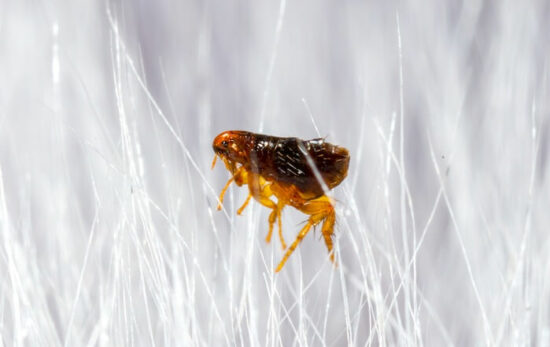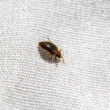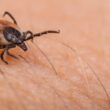Fleas can be a major pain that no one wants to deal with. In desperation, many people turn to insect repellent in an attempt to keep these critters away.
But does bug spray work on fleas? Or is it just a myth?
Read on to find out!
Table of contents
Does Bug Spray Work On Fleas?
Take a close look at any commercial bug spray, and you’ll likely see labels touting its efficiency against mosquitos and other flying pests. These products are made to protect you from the insects you’re most likely to encounter in the great outdoors. However, they can keep stubborn ground-dwelling insects off you as well.
So does bug spray work on fleas?
You’ll be happy to hear that most bug spray products will work to keep fleas away. However, how well the bug spray works depends entirely on its formulation and ingredients.
How Effective Is It?
Standard bug sprays work surprisingly well against fleas even though most manufacturers don’t include fleas on the list of affected insects. In fact, bug spray affects fleas in virtually the same way it affects mosquitos.
You see, most bug spray and mosquito repellent contains a blend of ingredients that are designed to throw off an insect’s ability to detect you. All biting insects have receptors that they use to find appropriate sources of food. For mosquitos, the receptors are on the antennae and legs.
On fleas, the neuroreceptors are a little more complex. But they serve the same purpose! They help to detect body heat and carbon dioxide (which are two things they’re attracted to).
Bug spray interferes with the bug’s ability to detect those all-important cues. It confuses the insect, essentially making you invisible and unpalatable. As long as those signal-jamming ingredients are on your body, the fleas will avoid you as much as possible!
Kinds Of Spray & Repellent You Can Use
Fleas are not an insect you should ignore. While they’re most known to plague pets and backyard mammals, they can easily bite you and cause trouble. Fleas are known disease carriers that can wreak havoc on your health. Plus, their ability to multiply can lead to a full-blown infestation if you’re not careful.
So now that you know bug spray works on fleas, it’s time to protect yourself! Here are a few types of repellents that work well against fleas.
1. DEET
DEET is short for N-Diethyl-meta-toluamide. It’s a synthetic chemical repellent that’s commonly used in bug sprays. You can find it in products like mosquito-repelling coils and candles as well.
DEET is one of the most common active ingredients in bug sprays. Since it became available for public use in the 1950s, DEET has been the go-to ingredient for most bug spray manufacturers.
It’s a yellow oil that you can safely apply to the skin as a topical solution. According to the EPA, DEET is safe for people of all ages when used correctly.
As a topical solution, DEET works on biting insects like fleas, mosquitos, chiggers, and more. The oil is the ingredient that’s responsible for confusing those all-important receptors fleas use to find you.
Bug sprays and repellent with DEET work very well against fleas. It effectively creates an invisible barrier that fleas will avoid. As long as the DEET is active and present on your skin, fleas should not bite you. Most will avoid trying to jump on you entirely.
2. Permethrin
Permethrin is another popular ingredient in bug sprays that can help repel fleas. It’s a synthetic chemical that belongs to the pyrethroid family.
While many confuse permethrin with pyrethrum, the two ingredients are a bit different. Permethrin is a chemical that’s formulated to act like pyrethrum. Because it’s made in a lab, permethrin is a little more versatile and stable.
That’s why you see it being used so much in bug-killing products. It’s a favorite in the agricultural industry to treat crops. However, higher concentrations are also used in products to treat lice, scabies, and more.
Permethrin acts as both an insecticide and a repellent that works well on fleas. Applying it directly to fleas will result in near-instant death. It works by wreaking havoc on the insect’s nervous system.
Generally, bug sprays contain lower concentrations of permethrin. There, it acts as a repellent that deters fleas from getting anywhere near. Like DEET, its mere presence can keep fleas away from whatever surface it’s applied to.
Quick Tip: Permethrin is considered safe for anyone over the age of two months old. However, it can also irritate the skin for some people. For this reason, it’s often used on clothes and gear as an added layer of protection that works on fleas.
3. Pyrethrum
Pyrethrum is one of the oldest bug repellents in the books! To this day, it’s a popular ingredient in commercial bug sprays.
Pyrethrum is a natural compound that comes from chrysanthemum flowers. It’s the stuff that synthetic alternatives like permethrin try to replicate.
It’s a fantastic bug spray that works on fleas and a number of other insects. Because it’s natural, pyrethrum is safe to use on organic farms. It’s also considered safe for use on human skin, which is why it’s utilized so much in bug sprays.
Pure pyrethrum can break down when exposed to water and extreme light. As a result, it’s often fortified with other ingredients when used in commercial bug sprays. Oftentimes, manufacturers pair it with DEET and permethrin to create a super-effective repellent for fleas!
How To Use Them Effectively
Using bug spray for fleas is a pretty straightforward process. However, there are ways to improve efficiency across the board.
Understanding the ingredients and how they work can make a huge difference.
Not all mosquito repellent you use for fleas is safe for use on the skin. Furthermore, different concentrations of ingredients can lead to varying degrees of protection.
The first thing you should do is read all of the available safety information. Check the label and make sure that the product is safe for use. Then, read the application instructions to ensure that you’re following all of the recommended safety guidelines.
Apply products with DEET and pyrethrum to any bits of exposed skin. You can also apply sprays with permethrin. However, you should always double-check the safety information to ensure that the concentration is suitable for skin use.
Some people are sensitive to the chemicals in bug spray regardless of its safety information. If you’re someone who experiences irritation pretty easily, it may be a good idea to perform a spot test first. Apply it to a small area and wait a few hours to ensure that you don’t have an allergic reaction.
If you respond well to the bug spray, apply it before you go outside and expose yourself to fleas. Pay close attention to your legs, as fleas tend to leap onto your lower appendages. Don’t forget any vulnerable spots on your arms, neck, and face, too.
For even more protection, invest in a separate permethrin-based bug spray to help repel fleas. There are many permethrin bug sprays out there that are specifically made for clothing and gear. They should not be applied to the skin.
Instead, spray them on your clothes, shoes, backpack, and tent. You can also apply it to any other product that will have exposure to the elements. Doing so can ensure that fleas don’t hop on and hitch a ride back to your home!
Natural Alternatives To Try
Prefer to adopt a more natural approach to pest control? Good news! There are plenty of great natural alternatives to commercial bug sprays that also work on fleas.
Chemical-based sprays have their merits and offer some of the best protection possible. But if you’re more sensitive to DEET or permethrin, they can cause more trouble in the long run. The following natural solutions to make DIY insect repellent for fleas may be a better fit to keep these critters at bay.
Neem Oil
You might have heard about the wonders of neem oil in the past. It’s a favorite among gardeners because it acts as an all-natural insect repellent for crops. Many people like to use it on the skin as a topical repellent for fleas, too.
Neem oil comes from the fruits and seeds of the neem tree, an evergreen plant that grows in India. Technically speaking, neem oil is a type of vegetable oil! It’s extracted through pressing and collected for use in a wide range of products.
As an insect repellent for fleas, all you have to do is spread a few drops on exposed skin. Like commercial bug sprays, it’s best to do some spot testing beforehand.
Tea Tree Oil
Tea tree oil is another all-natural oil. However, this one comes from the steaming leaves of the Australian tea tree.
It’s a versatile substance that you can find in everything from hair care products to mouth wash. The oil is revered for its antibacterial and anti-inflammatory properties.
The intense smell of tea tree oil is thought to be the biggest issue for fleas. While pleasant for us humans, the strong aroma of this oil works quite well on fleas and other insects. As a result, they avoid it at all costs when applied to the skin.
Peppermint Oil
Peppermint oil comes from the herb of the same name. It’s aromatic and has menthol compounds to work the sinuses.
Like tea tree oil, peppermint oil can be used as a bug repellent that works on fleas. You can use that to your advantage when trying to deter them.
You can apply the oil directly to the skin. Some people like to dilute it in water or carrier oil as well for easier application.
If you want to kill these bugs directly, peppermint oil mixes nicely with rubbing alcohol to create a powerful bug spray for fleas.
Cedar Oil
As you can guess, cedar oil comes from the bark of cedar trees.
It’s a natural insect repellent that works well against fleas and a wide range of other insects.
There are a few ways to use cedar oil. You can apply a few drops to the ground of infested areas. That should cause the flees to scatter and migrate elsewhere
Alternatively, you can add a few drops to water and spray the mixture onto your skin for protection wherever you go.
Final Thoughts
As long as you know how to apply it properly, bug spray works on fleas. The right insect repellent will give you peace of mind by keeping these critters away.
Stick with the products we recommended above, and fleas will be the last of your worries!


